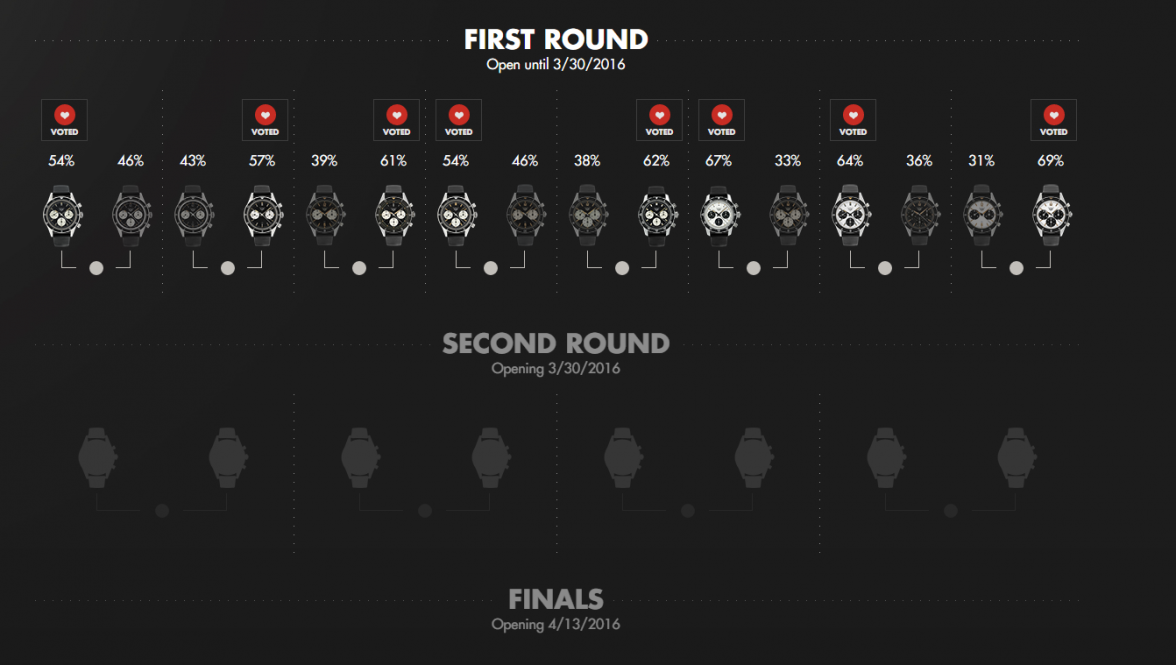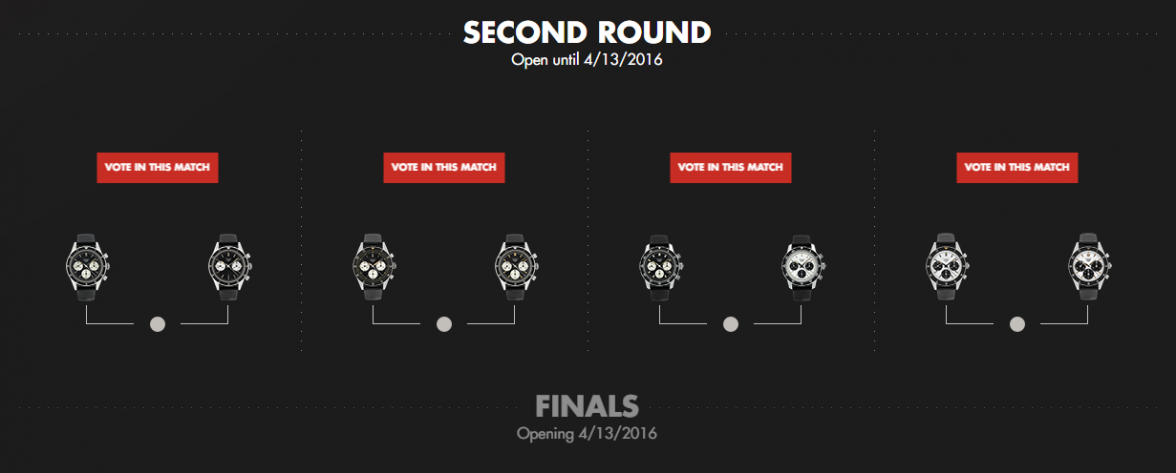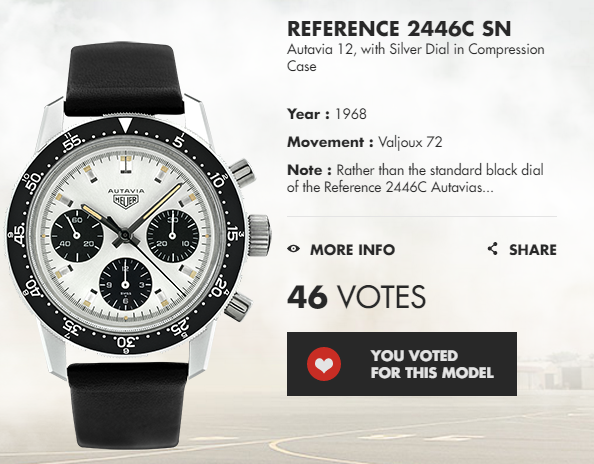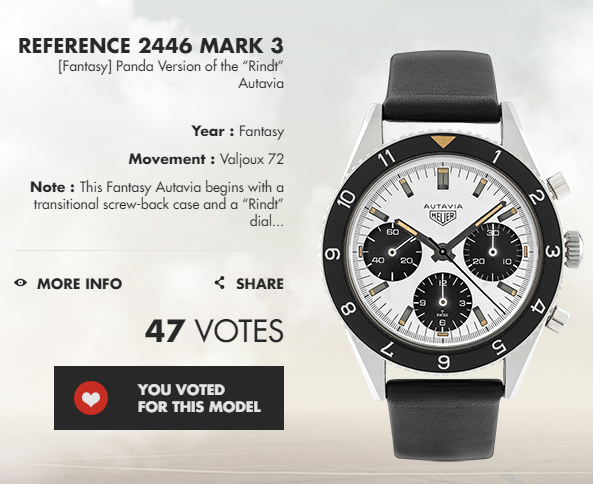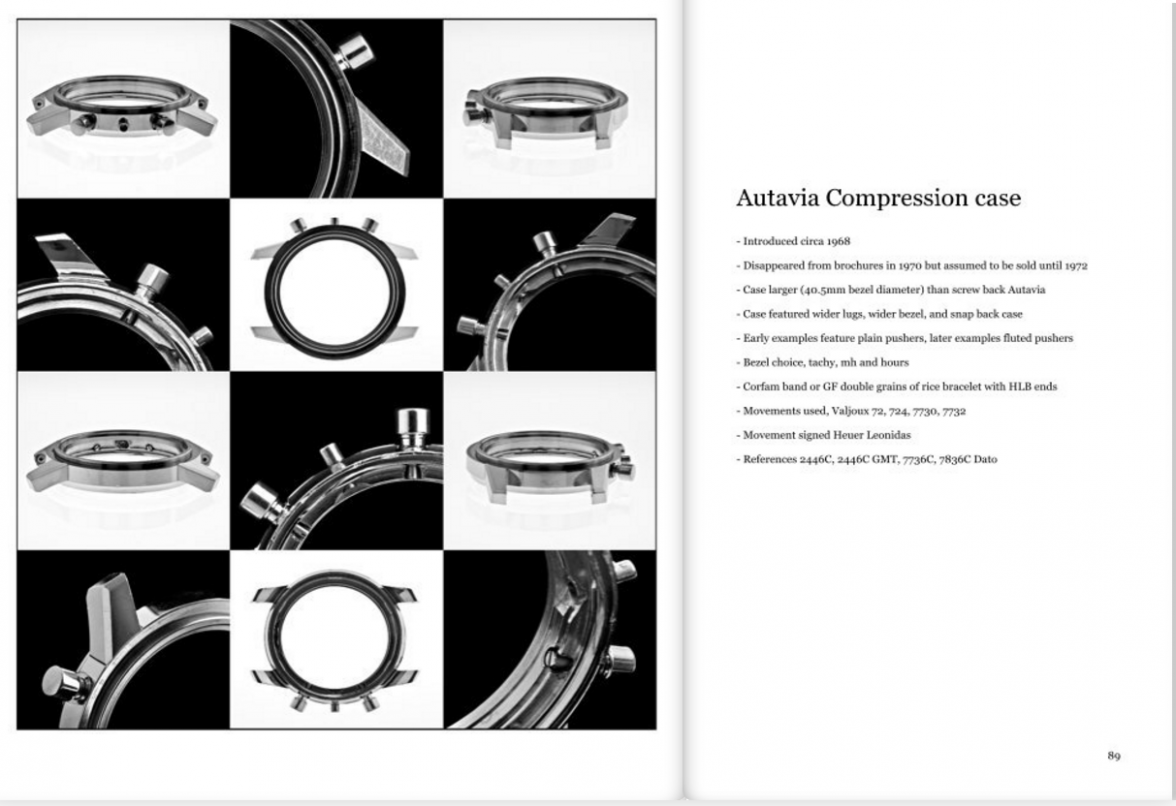TAG Heuer: The Autavia Cup
Big Adam
·Has second round opened for anyone yet?
I'm still seeing same image as posted by Hubert above.
I'm still seeing same image as posted by Hubert above.
elbeik
·The site is taking terribly long time to load over here...
Hubert
··TAG Heuer Forums Moderatorelbeik
·Well, we can almost be certain it'll be a tri-register, and if you guys feel the Force, a Panda...
imagwai
·Looks that way. I was really hoping for a black dialed (reverse panda) version. The three register is OK, but I think I'm veering towards the 2-register 1966 as my favourite.
Hubert
··TAG Heuer Forums Moderatorhttp://us.tagheuer.com/en/news/an-introduction-to-the-early-autavias-1962-to-1969
AN INTRODUCTION TO THE EARLY AUTAVIAS: 1962 TO 1969
On March 10, 2015, TAG Heuer launched the Autavia Cup
Autavia Cup, a unique event to allow brand enthusiasts to select the historic Autavia model that will be re-issued in 2017. Interest in the Autavia Cup has been exceptionally strong, with thousands of enthusiasts casting their votes in the first round of the competition.
To provide today’s enthusiasts with comprehensive information about the Autavia chronographs that are included in the Autavia Cup competition, TAG Heuer commissioned three vintage Heuer experts – Rich Crosthwaite, Paul Gavin and Jeff Stein – to provide an in-depth description of the Autavias produced by Heuer from 1962 to 1969. These experts have released their posting that covers approximately 25 models and executions produced by Heuer over this period. Today, in order to provide today’s enthusiasts with an introduction to the 1960s Autavias, we highlight three of the most celebrated models of the era.
Before turning to the watches themselves, we put the Autavia into its historic perspective. The Autavia marked three “firsts” for Heuer. The Autavia was Heuer’s first chronograph to have a model name, as the previous chronographs were identified only by their reference numbers. The Autavia was Heuer’s first chronograph to incorporate a rotating bezel, with this bezel providing a useful tool for the racer or pilot and also dramatically increasing the size of the Autavia, compared with Heuer’s earlier chronographs. Finally, the Autavia was the first wristwatch that Jack Heuer, at age 30, created for the company and he designed the Autavia to meet the specific needs of the racers. These factors, combined with the beautiful style and solid construction of the Autavia, resulted in this new chronograph becoming the watch of choice for the racers, navigators and pilots, throughout the 1960s.

The very first execution of the Autavia chronograph is distinguished by its oversized registers and the perfect match between the luminous markings on the dial and the luminous coating of the hands. This first Autavia was available in either a two-register model or a three-register model, that provided 12-hour capacity. As with all Autavias of the 1960s, the bezel rotated to allow the computation of elapsed time or tracking time in a second time zone, and the stainless steel case was guaranteed waterproof to 330 feet.

By the mid-1960s, Heuer had modified the Autavia to reflect the changing style of that decade. The bezels had become thinner and the hands were now brightly polished metal , again matching the bright finish of the markers on the dial. To comply with safety regulations, the luminous material was changed from radium to tritium, explaining the small “T” marking on these dials. The two versions shown above are especially important in Heuer’s history, with the three-register model being worn by Formula One World Champion, Jochen Rindt, and the two-register model being worn by Indianapolis 500 and Formula One champion, Mario Andretti.

Around 1968, Heuer reengineered the case used for the Autavia, with a compressor (snap-back) design replacing the previous screw-back configuration. The Autavia case became larger, going from 39 to 40.5 millimeters across the dial, and the lugs became wider, with a more angular shape. In a dramatic break from the previous models, Heuer now produced “Panda” dials for the Autavia, combining a brushed silver dial with black registers. Only a handful of these dials have survived, and these special Autavias are cherished by today’s collectors.
+++++++++++++++++++++++++
For our experts description of the early Autavias, see “An In-Depth Look at the First Autavias (1962 through 1969)”, by Messrs. Crosthwaite, Gavin and Stein HERE
Rich and Paul have authored the book, Heuer Autavia Chronographs 1962-85, which provides a complete history of the Autavia, with hundreds of beautiful watch photos, as well as scans of historic documents. You can order the book HERE
abrod520
·Yes, I think so too.
I am still hoping my original choice will be the winner.
But I would also be content if this one won.
Why is the compressor case your choice when you can already buy one - for under US$ 2000?
http://www.sinn.de/en/Archive/103.htm
http://www.watchrecon.com/?query=sinn+103
--------------
If the watch gods are listening, please give us a case with beautiful lugs
Hubert
··TAG Heuer Forums ModeratorWhy is the compressor case your choice when you can already buy one - for under US$ 2000?
--------------
If the watch gods are listening, please give us a case with beautiful lugs
I stand by my choice. I think the Compression case & lugs look great with this design.
Edited:
Hubert
··TAG Heuer Forums ModeratorGreat interview with Jeff Stein from OnTheDash:
http://en.worldtempus.com/article/industry-news/tag-heuer-interview-jeff-stein-2454069
http://en.worldtempus.com/article/industry-news/tag-heuer-interview-jeff-stein-2454069
You are a key player in the Autavia Cup project. What was your role?
I met Jean-Claude Biver in November 2015, and he was familiar with the huge recent increase in interest in the 1960s Autavias. We actually looked through OnTheDash together, and he was very interested to understand which models are most sought after by today’s collectors. He wanted a round case from the 1960s, rather than a cushion or a C-shape case. I mustered some courage and told him that TAG Heuer needs to re-issue the Autavia, to address this amazing interest in the vintage models. With a room full of TAG Heuer people listening, he said, “Tell me exactly which model you want, and we will re-issue it in 2017.” The team at TAG Heuer came up with the idea of a head-to-head, knock-out competition to select the model to be re-issued, and soon we were working on the “Autavia Cup” competition. Together with Paul Gavin, another vintage Heuer collector, we selected the historic models that are included in the competition. And then Paul created the four “Fantasy” models” using Photoshop. We thought that the “Fantasy” models made it more interesting and some people in re-issue prefer not a literal one but something inspired by the original.
It is interesting that TAG Heuer selected only Autavias from the 1960s for the Autavia Cup competition, rather than any of the later models. How does this choice mesh with your own preferences?
There is a fundamental difference between the 1960s Autavias and the 1970s Autavias. The 1960s models are all manual-wind models, in round cases with traditional lugs. In 1969, when Heuer introduced the automatic chronographs, the cases were changed to a larger C-shape case, to accommodate the new movement. Heuer made some beautiful Autavias in the 1970s, but my personal preference is for the 1960s models. The watch is thinner and lighter; the styling more pure; these earlier models feel perfect on my wrist and look perfect to my eye! So at least for me, TAG Heuer made the right choice!

The Autavia Cup is more than just a contest; it is a tribute to TAG Heuer’s heritage. Your thoughts?
From what I have heard, this is the first time that a major watch brand has turned to its enthusiasts, through social media, to select a model to be re-issued. The Autavia is the perfect subject for this type of event, because back in the 1960s and 70s, the Autavia was the model that the racers wanted. Jack Heuer tells the stories of providing 18 karat gold Carreras to the Ferrari drivers, but he was also selling the Autavias, in the 1960s, at club events, local rallies, etc. If the Autavia was the “racers’ chronograph”, back then, it seems right to have enthusiasts select the next model of the Autavia, for 2017.
imagwai
·The final 4 are now up for the last vote. I clicked on one thinking I could change my mind like I did in the previous rounds but have ended up voting for the wrong one I think. Doh!
Big Adam
·Kudos to TH for going all the way with a third vote!
The "Hubert" 2446C SN has my vote too.
The "Hubert" 2446C SN has my vote too.
imagwai
·Got my vote changed. Afraid I'm really after a black-dial and only a single set of numbers on the bezel so went for the 1966 2446 Mark 3 Rindt.
Big Adam
·How very dare you!
😀
😀
abrod520
·Ah well, if you guys have your way and vote in an ugly 2446C I guess that's $6k I can spend elsewhere... after all, 2017 is the 50th anniversary of the Omega Speedmaster, Seamaster 300 and Railmaster, and I expect there'll be something quite interesting up Omega's sleeve!
elbeik
·Hopefully a human-sized Railmaster, and most probably a new color palette for the Speedmaster.
abrod520
·Some of the color palettes on the Speedmaster Professional have been pretty cool IMO. The blue-dial Gemini IV and the titanium Apollo XI 45th Anniversary are both a lot of fun to wear!
Though I do hope we're done with the different Sides of the Moon too. The original was really cool, but it's getting a bit ridiculous now
Though I do hope we're done with the different Sides of the Moon too. The original was really cool, but it's getting a bit ridiculous now
